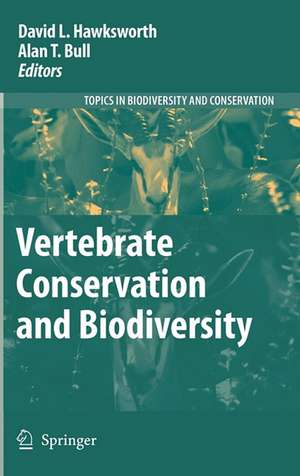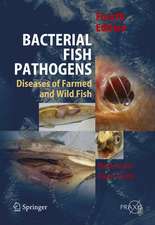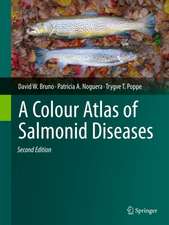Vertebrate Conservation and Biodiversity: Topics in Biodiversity and Conservation, cartea 5
Editat de David L. Hawksworth, Alan T. Bullen Limba Engleză Hardback – 24 mai 2007
| Toate formatele și edițiile | Preț | Express |
|---|---|---|
| Paperback (1) | 1226.73 lei 6-8 săpt. | |
| SPRINGER NETHERLANDS – 22 noi 2010 | 1226.73 lei 6-8 săpt. | |
| Hardback (1) | 1236.38 lei 6-8 săpt. | |
| SPRINGER NETHERLANDS – 24 mai 2007 | 1236.38 lei 6-8 săpt. |
Din seria Topics in Biodiversity and Conservation
- 24%
 Preț: 1605.63 lei
Preț: 1605.63 lei - 18%
 Preț: 1239.49 lei
Preț: 1239.49 lei - 18%
 Preț: 947.50 lei
Preț: 947.50 lei - 18%
 Preț: 1218.21 lei
Preț: 1218.21 lei - 18%
 Preț: 942.31 lei
Preț: 942.31 lei - 18%
 Preț: 944.51 lei
Preț: 944.51 lei -
 Preț: 435.38 lei
Preț: 435.38 lei - 15%
 Preț: 646.62 lei
Preț: 646.62 lei - 24%
 Preț: 806.76 lei
Preț: 806.76 lei - 18%
 Preț: 1114.65 lei
Preț: 1114.65 lei - 18%
 Preț: 1126.35 lei
Preț: 1126.35 lei - 18%
 Preț: 1834.27 lei
Preț: 1834.27 lei - 18%
 Preț: 1019.49 lei
Preț: 1019.49 lei - 18%
 Preț: 1236.38 lei
Preț: 1236.38 lei - 18%
 Preț: 1231.47 lei
Preț: 1231.47 lei - 18%
 Preț: 1230.66 lei
Preț: 1230.66 lei - 18%
 Preț: 1232.71 lei
Preț: 1232.71 lei - 18%
 Preț: 1376.53 lei
Preț: 1376.53 lei - 18%
 Preț: 944.51 lei
Preț: 944.51 lei
Preț: 1236.38 lei
Preț vechi: 1507.77 lei
-18% Nou
Puncte Express: 1855
Preț estimativ în valută:
236.61€ • 256.92$ • 198.75£
236.61€ • 256.92$ • 198.75£
Carte tipărită la comandă
Livrare economică 22 aprilie-06 mai
Preluare comenzi: 021 569.72.76
Specificații
ISBN-13: 9781402063190
ISBN-10: 1402063199
Pagini: 508
Ilustrații: X, 494 p.
Dimensiuni: 155 x 235 x 27 mm
Greutate: 0.98 kg
Ediția:2007
Editura: SPRINGER NETHERLANDS
Colecția Springer
Seria Topics in Biodiversity and Conservation
Locul publicării:Dordrecht, Netherlands
ISBN-10: 1402063199
Pagini: 508
Ilustrații: X, 494 p.
Dimensiuni: 155 x 235 x 27 mm
Greutate: 0.98 kg
Ediția:2007
Editura: SPRINGER NETHERLANDS
Colecția Springer
Seria Topics in Biodiversity and Conservation
Locul publicării:Dordrecht, Netherlands
Public țintă
ResearchCuprins
Responses of plant and bird communities to prescribed burning in tallgrass prairies.- Population trends and spatial synchrony in peripheral populations of the endangered Lesser grey shrike in response to environmental change.- Monitoring mammals in the Caxiuanã National Forest, Brazil – First results from the Tropical Ecology, Assessment and Monitoring (TEAM) program.- Grassland versus non-grassland bird abundance and diversity in managed grasslands: local, landscape and regional scale effects.- Biogeographic patterns of the East African coastal forest vertebrate fauna.- Sooty Shearwater (Puffinus griseus) on Guafo Island: the largest seabird colony in the world?.- Mexico in the international reptile skin trade: a case study.- Use of forest fragments by blue-winged macaws (Primolius maracana) within a fragmented landscape.- Commercialization and use of snakes in North and Northeastern Brazil: implications for conservation and management.- Philopatry, dispersal patterns and nest-site reuse in Lesser Grey Shrikes (Lanius minor).- Conservation biogeography of anurans in Brazilian Cerrado.- Avian responses to tourism in the biogeographically isolated high Córdoba Mountains, Argentina.- Population decline of loggerhead turtles: two potential scenarios for Fethiye beach, Turkey.- Habitat use, roost selection and conservation of bats in Tsingy de Bemaraha National Park, Madagascar.- Territoriality and Survivorship of the Sierra Madre Sparrow in La Cima, México.- Analysis of the species description process for a little known invertebrate group: the limnoterrestrial tardigrades (Bilateria, Tardigrada).- Environmental correlates for species richness among amphibians and reptiles in a climate transition area.- Amphibian diversity in East African biodiversity hotspots:altitudinal and latitudinal patterns.- China Subregional Avian Endemism and Biodiversity Conservation.- How resilient are Andean montane forest bird communities to habitat degradation?.- Human and natural impacts on forests along lower Tana river, Kenya: implications towards conservation and management of endemic primate species and their habitat.- Fragmentation causes rarity in common marmosets in the Atlantic forest of northeastern Brazil.- Distribution, abundance, and habitat use of introduced Boa constrictor threatening the native biota of Cozumel Island, Mexico.- Camera-trap studies of maned wolf density in the Cerrado and the Pantanal of Brazil.- Mammal survey at a ranch of the Brazilian Cerrado.- Surveying carnivores at large spatial scales: a comparison of four broad-applied methods.- Habitat and landscape factors associated with neotropical waterbird occurrence and richness in wetland fragments.- Livestock husbandry as a tool for carnivore conservation in Africa’s community rangelands: a case–control study.- Comparison of funding and demand for the conservation of the charismatic koala with those for the critically endangered wombat Lasiorhinus krefftii.- Nest site selection in middle and great spotted woodpeckers Dendrocopos medius & D. major: implications for forest management and conservation.- An Evaluation of the Contribution of Cultivated Allspice (Pimenta Dioca) to Vertebrate Biodiversity Conservation in Nicaragua.
Textul de pe ultima copertă
This book brings together a selection of original studies submitted to Biodiversity and Conservation that address the conservation and biodiversity of vertebrates - particularly those in terrestrial habitats. Vertebrates are, along with plants, the best-known and most intensively studied components of biological diversity on Earth. While studies on vertebrates can be expected to provide models for other groups, they can also pose their own particular problems due to their relative mobility as in some migratory birds. In addition, many mammals and fish are also subject to extensive human exploitation for food or sport.
The contributions in this volume are drawn from a wide range of countries – from Australasia, East Africa, Europe, and North, Central and South America. Collectively they provide a snap-shot of the types of studies and actions being taken in vertebrate conservation – topical examples that will make the volume especially valuable for use in conservation biology courses.
Reprinted from Biodiversity and Conservation, volume 16:4 (2007)
The contributions in this volume are drawn from a wide range of countries – from Australasia, East Africa, Europe, and North, Central and South America. Collectively they provide a snap-shot of the types of studies and actions being taken in vertebrate conservation – topical examples that will make the volume especially valuable for use in conservation biology courses.
Reprinted from Biodiversity and Conservation, volume 16:4 (2007)
Caracteristici
Draws together a wide range of peer-reviewed primary research papers from biodiversity researchers around the world Provides examples from a wide spectrum of issues representing the current state-of-the art in arthropods Provides examples of recent work, usable as case studies for courses in ecology, restoration, biodiversity, conservation Enables specialist researchers to see primary research papers tackling problems in arthropods





